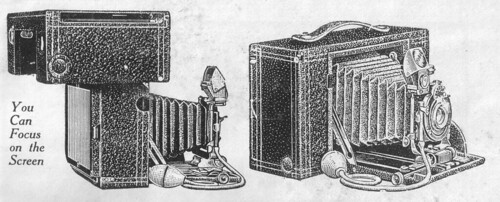Difference between revisions of "No. 4 Screen Focus Kodak"
m |
|||
| Line 6: | Line 6: | ||
}}{{br}} | }}{{br}} | ||
| − | At the turn from the 19th to the 20th century the inconvenience with the new rollfilm cameras concerning the way of estimated image composition through the viewfinder led to a new type of camera, the combination camera. This type had a rollfilm back that could be swung out of the focal plane to give place for a ground glass. [[Blair]] offered the ''No. 3 Combination Hawk-Eye''. [[Manhattan Optical Co.|Manhattan Optical]] sold its ''Wizard Duplex''. And [[Kodak]] its '''No. 4 Screen Focus Kodak'''. The rollfilm back could be removed completely so that the camera served as 4×5" plate camera. In 1905 the camera was equipped with Rapid Rectilinear lens and a Kodak Automatic shutter. It had a rising and sliding front and even a viewfinder, a brilliant reversible finder with hood. It used type No. 123 roll film for 4×5" exposures. It was a very expensive camera, The concurrent model of Blair | + | At the turn from the 19th to the 20th century the inconvenience with the new rollfilm cameras concerning the way of estimated image composition through the viewfinder led to a new type of camera, the combination camera. This type had a rollfilm back that could be swung out of the focal plane to give place for a ground glass. [[Blair]] offered the ''No. 3 Combination Hawk-Eye''. [[Manhattan Optical Co.|Manhattan Optical]] sold its ''Wizard Duplex''. And [[Kodak]] its '''No. 4 Screen Focus Kodak'''. The rollfilm back could be removed completely so that the camera served as 4×5" plate camera. In 1905 the camera was equipped with Rapid Rectilinear lens and a Kodak Automatic shutter. It had a rising and sliding front and even a viewfinder, a brilliant reversible finder with hood. It used type No. 123 roll film for 4×5" exposures. It was a very expensive camera, The concurrent model of Blair did cost just one third. However, ca. 4000 No. 4 Screen Focus were made. |
==Links== | ==Links== | ||
Revision as of 22:43, 11 November 2007

|
At the turn from the 19th to the 20th century the inconvenience with the new rollfilm cameras concerning the way of estimated image composition through the viewfinder led to a new type of camera, the combination camera. This type had a rollfilm back that could be swung out of the focal plane to give place for a ground glass. Blair offered the No. 3 Combination Hawk-Eye. Manhattan Optical sold its Wizard Duplex. And Kodak its No. 4 Screen Focus Kodak. The rollfilm back could be removed completely so that the camera served as 4×5" plate camera. In 1905 the camera was equipped with Rapid Rectilinear lens and a Kodak Automatic shutter. It had a rising and sliding front and even a viewfinder, a brilliant reversible finder with hood. It used type No. 123 roll film for 4×5" exposures. It was a very expensive camera, The concurrent model of Blair did cost just one third. However, ca. 4000 No. 4 Screen Focus were made.
Links
- No. 4 Screen Focus Kodak at Antique & 19th Century Cameras [1]
- No. 4 Screen Focus Kodak as plate camera at Kodak Collector's [2]
- Model A at George Eastman Archives [3]